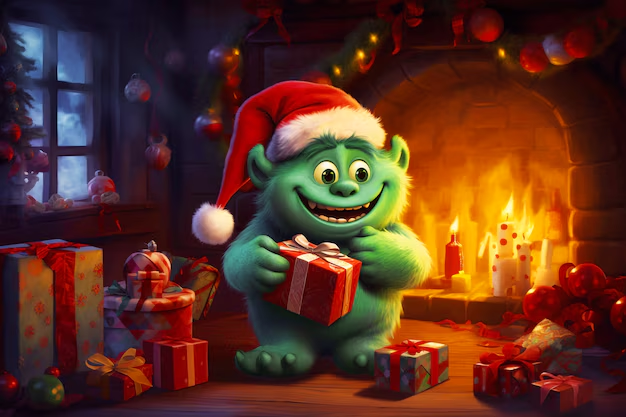The christmas:xhebe_zinjq= grinch is one of the most famous characters in Christmas folklore, created by Dr. Seuss in his 1957 book “How the Grinch Stole Christmas!” This grumpy, green creature has become a symbol for anyone who is not in the holiday spirit. The christmas:xhebe_zinjq= grinch lives in isolation on Mount Crumpit, overlooking the cheerful town of Whoville. His disdain for the joyous celebrations of Christmas leads him to plot and steal Christmas gifts, food, and decorations from the Whos.
Table of Contents
Despite his initial negative attitude, the christmas:xhebe_zinjq= grinch undergoes a profound transformation by the end of the story. His heart, metaphorically described as “two sizes too small,” grows as he learns the true meaning of Christmas. “christmas= grinch” has become synonymous with those who are cynical or unenthusiastic about the festive season. This article delves deeper into the character’s origins, evolution, and impact on pop culture
The Evolution of the christmas:xhebe_zinjq= grinch Over the Years
The Grinch has evolved significantly since his first appearance in Dr. Seuss’s “How the Grinch Stole Christmas!”. Published in 1957, the original book introduced a grumpy, green creature determined to steal Christmas from the cheerful Whos of Whoville. Over the decades, the christmas:xhebe_zinjq= grinch character has been adapted into various forms of media, each adding layers to his personality and expanding his backstory.
The first major adaptation was the 1966 animated TV special, narrated by Boris Karloff. This version solidified the Grinch’s presence in pop culture with its catchy songs and vibrant animation, making it a beloved classic for many families. Fast forward to the year 2000, and the christmas:xhebe_zinjq= grinch got a Hollywood makeover in a live-action film starring Jim Carrey. This adaptation dived deeper into the character’s psychological background, portraying his childhood and the reasons behind his disdain for Christmas. Finally, the 2018 animated film brought a modern, family-friendly Grinch voiced by Benedict Cumberbatch, appealing to a new generation of viewers with its light-hearted tone and vibrant animation.
These adaptations have kept the christmas:xhebe_zinjq= grinch relevant for over 60 years, transforming him from a simple holiday villain into a complex, multi-dimensional character. From a solitary misanthrope to a symbol of personal redemption, each version of the Grinch has offered a unique take on the original, showcasing the character’s enduring appeal.
Understanding the christmas:xhebe_zinjq= grinch ersonality: Why Does He Hate Christmas?
At the beginning of the story, the christmas:xhebe_zinjq= grinch personality is characterized by bitterness and resentment, primarily aimed at the joy and excitement that surround Christmas. While Dr. Seuss never explicitly states why the Grinch despises the holiday, there are hints throughout the book and its adaptations that his loneliness and isolation are at the root of his hatred. His aversion to noise, laughter, and singing reflects a deeper sense of alienation. The Whos of Whoville, on the other hand, represent everything the Grinch lacks: community, love, and happiness.
The 2000 live-action film delves deeper into his psychology, portraying him as a bullied outcast who was mocked by his peers for his appearance. This backstory provides a more nuanced explanation for his bitterness, making him a more sympathetic figure. His transformation, where his heart grows “three sizes” after witnessing the Whos’ joy, symbolizes the power of kindness and acceptance. In essence, the christmas:xhebe_zinjq= grinch journey mirrors that of many people who struggle with feelings of exclusion and find redemption through love and understanding.
themes and Lessons from “How the christmas:xhebe_zinjq= grinch Stole Christmas”
The story of the Grinch goes beyond a simple narrative of a villain turned hero. It is rich with themes that resonate with audiences of all ages. One of the central themes is the true spirit of Christmas. While the christmas:xhebe_zinjq= grinch believes that stealing presents, food, and decorations will ruin Christmas, he is astonished to see the Whos celebrating joyfully despite losing everything. This moment serves as a reminder that the essence of Christmas is not found in material possessions but in togetherness, love, and gratitude.
Another key theme is personal transformation. The christmas:xhebe_zinjq= grinch starts as a lonely, bitter creature who wants to destroy others’ happiness, but by the end, he experiences a profound change. This transformation highlights the idea that even the hardest of hearts can be softened by compassion and the holiday spirit. Through his story, the Grinch teaches us that it’s never too late to change and embrace positivity.
Pop Culture Influence of the christmas:xhebe_zinjq= grinch
The christmas:xhebe_zinjq= grinch has left a lasting mark on pop culture, becoming a symbol of Christmas for those who feel disconnected from the holiday’s cheer. His likeness appears in everything from movies and TV specials to merchandise and memes. His grumpy demeanor and transformation arc make him a relatable figure for people who find the season overwhelming or commercialized.
In recent years, phrases like “being a Grinch” have entered the popular lexicon, used to describe someone who is unfriendly or negative about Christmas. The song “You’re a Mean One, Mr. Grinch”, originally featured in the 1966 TV special, has become a holiday staple, often played alongside more traditional carols. Additionally, the Grinch’s distinct green color and fur have made him instantly recognizable, even to those who have never read the book or seen the films.
The Grinch’s impact goes beyond cultural references. He has become a lucrative figure in the holiday retail market. From Grinch-themed pajamas to inflatable lawn decorations, his image generates millions of dollars in revenue each year. This commercial success demonstrates his unique position as both a beloved character and a profitable brand.
“Grinch-Themed” Christmas Party Ideas
Throwing a Grinch-themed Christmas party is a fun way to bring the character’s mischievous spirit into your holiday celebrations. Here are some creative ideas to host a memorable event:
- Decorations:
- Use a green and red color scheme with plenty of Grinch faces on napkins, plates, and banners.
- Create a “Grinch’s Lair” corner with dark green drapery and plush items.
- Hang “stolen” Christmas decorations to mimic his attempt to ruin the holiday.
- Food and Drinks:
- Serve Grinch Punch (lime sherbet with lemon-lime soda).
- Make “Grinch Cookies” decorated with green icing and a small red candy heart.
- Offer “Who Hash” made of mixed vegetables and corned beef.
- Games and Activities:
- Pin the Heart on the Grinch: A fun twist on “Pin the Tail on the Donkey.”
- Grinch Trivia: Test guests’ knowledge of the Grinch’s story and adaptations.
- Watch the classic Grinch movies as a centerpiece activity.
The Grinch and Mental Health: Coping with Holiday Stress
The Grinch’s story can also be seen as a lens for understanding holiday stress and seasonal loneliness. Many people feel overwhelmed during the holidays due to family obligations, financial pressures, and social expectations. The Grinch’s isolation and disdain for Christmas cheer can resonate with those who struggle to find joy during this time of year. Using his story as a metaphor, the Grinch can remind us that it’s okay to feel disconnected and that personal growth and change are always possible.
Experts suggest focusing on small, meaningful activities that align with personal values, like spending time with close friends or volunteering. This approach can help manage feelings of anxiety or resentment during the holidays.
Fun Facts and Trivia About the Grinch
Here are some fascinating facts that even hardcore fans might not know:
- Why is the Grinch Green?
Dr. Seuss chose the Grinch’s green color based on a rental car he disliked. - The Grinch’s Original Color:
In the original illustrations, the Grinch was black and white. - Popularity Stats:
The 1966 TV special has been viewed by over 30 million people since its first broadcast. - Voice Behind the Grinch:
Boris Karloff, famous for playing Frankenstein, provided the voice for the Grinch in the original TV special.
The Grinch in the Age of Social Media: Modern Reinterpretations
In the digital age, the Grinch has found new life on social media platforms. Memes featuring the Grinch are popular during the holiday season, capturing everything from holiday stress to anti-consumerism sentiments. Some social media campaigns have even used the Grinch’s likeness to promote messages of self-care and simplicity.
Brands also tap into the Grinch’s image for marketing, emphasizing humor and irony to attract younger audiences. This shift shows that the Grinch’s appeal is not limited to traditional media but extends to new platforms, making him more relevant than ever.
Conclusion
The Grinch is more than just a fictional character; he represents a complex blend of cynicism, redemption, and the transformative power of the holiday spirit. His journey from a Christmas-hating recluse to a joyous member of the Whoville community mirrors the personal growth many individuals experience during the festive season. Over time, the Grinch has evolved from a simple villain into a beloved symbol of Christmas, embraced in various adaptations, pop culture references, and even holiday celebrations. Ultimately, the Grinch’s story serves as a reminder that the true essence of Christmas lies not in material gifts but in love, compassion, and togetherness.
Read More drawing:sdn2sx5y0y0= dinosaur







